Developing an Evaluation System Suitable for Coastal Rural Houses’ Characteristic Style and Its Inspiration for Rural Revitalization: Case Study of Rongcheng in Shandong Province
Abstract
:1. Introduction
2. Theoretical Underpinning
2.1. Rural Houses’ Characteristic Style
2.2. Index System of Rural Houses’ Characteristic Style
3. Methods, Region and Data Processing
3.1. Study Area
3.2. Data Sources
3.3. Methods
3.3.1. Construction of Evaluation Index System
3.3.2. Construction of Regionalization Index System
3.3.3. Cluster Analysis
4. Results and Analysis
4.1. Evaluation of Coastal Rural Houses’ Characteristic Style
4.1.1. Analysis of Comprehensive Evaluation Results
4.1.2. Analysis of Single-Factor Evaluation Results
4.2. Regionalization of Coastal Rural Houses’ Characteristic Style
5. Discussion
5.1. The Relationship between Characteristic Style Development Direction of Rural Houses and the Rural Revitalization
5.2. Policy Recommendations
- (1)
- Historical culture + industrial development characteristic area. This region includes Dongchu Island Village, Malangou Village and Jiayuwang Village, located in the eastern coastal areas of Rongcheng City. The traditional houses, ancient trees, antiquities and coastline scenery, modern fishery, ecological agriculture and industrial tourism combine leisure tourism and cultural heritage. Dongchu Island Village builds a marine historical and cultural display base through a rural memory hall, fisherman life experience, seagrass house living experience, etc. (Figure 8). Malangou Village uses the fisherman station and swan lake park construction to create a waterfront customs history display village. Jiayuwang Village is a key cultural tourism brand in Rongcheng City, integrating red tourism, ecological sightseeing, folk experience and cultural industry.
- (2)
- Folk customs + industrial development characteristic area. This area includes Yuankuang Village and Muyunan Village, located in the south of Rongcheng City. The beach shoreline resources of the coastal villages in the village are rich, the area of seawater aquaculture is large, and the number of fishing ports and docks is large. It is combined with good leisure projects, industrial tourism, the Shawo fishing port and the Chashan scenic spot, tasting delicious seafood, purchasing high-quality local products, viewing mountain and sea scenery and experiencing farming, sea and animal husbandry fish scenery. Muyunan Village is located in the southeast coastal area of the Chishan Scenic Area. With the excellent natural landscape resources and profound historical and cultural heritage of the Chishan Scenic Area as the core and the village’s own unique painting and calligraphy culture as the divergence point, it complements the Chishan Scenic Area in function and landscape and has become an important leisure and vacation comprehensive service area in the south of Rongcheng.
- (3)
- Natural scenery characteristic area. The region is located in the Good Luck Corner Resort on the northeast coast of Rongcheng City, which is covered by seven sample villages: Yandunjiao Community, Donggu Village, Xiaoxi Village, Weiwei Village, Dongyandun Community, Dazhuangxujia Community and Xiangjiazhai Village, mainly including the three towns of Gangxi, Chengshan and Lidao. The villages in the area have a certain natural foundation and form an area with Beihai scenery, Wanmu Forest Park, Xixiakou Village and scenic spots. Relying on the advantageous resources such as the Naxianghai Scenic Area, Chengshan Forest Farm Leisure Resort, Jiming Island, Hekou Fishing Village, Datian E National Nature Reserve, Chaoyang Port and Mashan to make use of the sea and increase interest and extend the tourist routes of Xixiakou Scenic Area, the combination of ecological protection, sightseeing photography tourism and leisure fishery is adopted. Thus, the characteristics of the village and the planning area are taken together, from all aspects of the pastoral dream, rural dream and the future dream as a planning foothold.
- (4)
- Folk customs characteristic area. This area includes Quge Village, Zhimatan Village, Liu Village, Suohou Wangjia Village, Suohou Lujia Village, etc., and is located in the Shidao Bay Tourist Resort in the southeast of Rongcheng. Through the cultivation of characteristic projects, the greening in and around the village and in courtyards is strengthened, enhancing the village environment and vigorously creating pastoral scenery. Using agricultural planting and breeding, tourist experience activities should be carried out, and through the experience of agricultural production activities, the purpose of farming experience should be achieved.

6. Conclusions and Research Prospects
6.1. Conclusions
6.2. Research Limitations and Prospects
Author Contributions
Funding
Institutional Review Board Statement
Informed Consent Statement
Data Availability Statement
Conflicts of Interest
References
- Ministry of Housing and Urban-Rural Development of the People’s Republic of China, General Administration of Quality Supervision, Inspection and Quarantine of the People’s Republic of China. GB50357–2005 Code for Protection Planning of Historic and Cultural Cities; Architecture & Building Press: Beijing, China, 2003.
- Jiang, G.; Zhang, F.; Chen, X.; Wang, W.; Wu, J. On Countryside Urbanization and Preservation of Countryside Characteristics. Res. Agric. Mod. 2004, 25, 198–201. [Google Scholar]
- Kang, J.; Zhang, J.; Hu, H.; Zhou, J.; Xiong, J. Analysis on the spatial distribution characteristics of Chinese traditional villages. Prog. Geogr. 2016, 35, 839–850. [Google Scholar]
- Li, B.; Yang, F.; Dou, Y. The organic renewal of the human settlement environment in traditional villages: Theoretical cognition and practical path. Geogr. Res. 2022, 41, 1407–1421. [Google Scholar]
- Deng, Y.; Fu, X.; Zheng, W. Representation, measurement and attribution of spatial order of traditional villages in southern Hunan. Geogr. Res. 2021, 40, 2722–2742. [Google Scholar]
- Fang, Y.; Liu, J. Cultural landscape evolution of cluster agricultural village: The case of Yukou village in Shandong province. Geogr. Res. 2009, 28, 968–978. [Google Scholar]
- Weng, S.; Lu, J. The local practices and legitimacy construction in spatial gover-nance: A case study of traditional village protection in Furong village, Zhejiang province. Geogr. Res. 2019, 38, 1322–1332. [Google Scholar]
- Wang, Y.; Guo, H.; Yang, L. The Discussion on Evaluation and Sustainable Development Models of Traditional Villages in Western Mountainous Area of Beijing. Sci. Geogr. Sin. 2006, 26, 735–742. [Google Scholar]
- Tao, W.; Chen, H.; Lin, J. Spatial form and spatial cognition of traditional village in syntactical view:A case study of Xiaozhou Village, Guangzhou. Acta Geogr. Sin. 2013, 68, 209–218. [Google Scholar]
- Chen, X.; Li, W. Spatial Characteristic of Traditional Village Group from Regional Perspective—A Case Study of Traditional Villages in Lishui. Econ. Geogr. 2016, 36, 185–192. [Google Scholar]
- Zhao, Y.; Zhang, J.; Li, N.; Liang, L. The Study on Conservation Evaluation System and Method on the Historic Cultural Towns & Villages-A Case Study of The First Group Famous Historic and Cultural towns & Villages in China. Acta Geogr. Sin. 2006, 26, 497–505. [Google Scholar]
- Zhang, Z.; Yang, Q.; Wang, L.; Su, K.; Kuang, C. Traffic accessibility analysis of traditional villages in minority areas: A case study of Tongren City, Guizhou Province. Resour. Sci. 2018, 40, 2296–2306. [Google Scholar]
- Li, B.; Xu, C.; Zheng, S.; Wang, S.; Dou, Y. Spatial layout characteristics of Ethnic Minority villages based on pattern language: A case study of Southern Dong Area in Xiangxi as an example. Sci. Geogr. Sin. 2020, 40, 1784–1794. [Google Scholar]
- Qin, X.; Li, X.; Chen, W.; Zhang, X. Spatial pattern and influenceing factors of ethnic minority villages in the yangtze river economic belt. Huanman Geogr. 2022, 37, 118–130. [Google Scholar]
- Zhou, T.; Huang, Y.; Wang, X. An analysis of the conservation evaluation system of historic towns and villages in southwest China. Urban Plan. Forum 2011, 6, 109–116. [Google Scholar]
- Lei, W. Research on the Creation of the Features and Characteristics of Urban Waterfront of Xiangxi; Central South University: Changsha, China, 2012. [Google Scholar]
- Zou, J.; Chen, H.; Huang, W.; Liu, P. Quantitative evaluation on the living state of traditional villages. Sci. Geogr. Sin. 2020, 40, 908–917. [Google Scholar]
- Zhou, Y.; Huang, H.; Liu, Y. The spatial distribution characteristics and influencing factors of Chinese villages. Acta Geogr. Sin. 2020, 75, 2206–2223. [Google Scholar]
- Cao, Z.; Liu, Y.; Li, Y.; Wang, Y. Spatial pattern and its influencing factors of specialized villages and towns in China. Acta Geogr. Sin. 2020, 75, 1647–1666. [Google Scholar]
- Xiong, M. Research progress and disciplinary approach of chinese traditional drellings. City Plan. Rev. 2017, 41, 102–112. [Google Scholar]
- Cloke, P.J. An index of rurality for England and Wales. Reg. Stud. 1977, 11, 31–46. [Google Scholar] [CrossRef]
- Shi, Y. Summary of research on rural economic types and regionalization. Chin. J. Agric. Resour. Reg. Plan. 1993, 2, 61–64. [Google Scholar]
- Long, H.; Liu, Y.; Zou, J. Assessment of Rural Development Types and Their Rurality in Eastern Coastal China. Acta Geogr. Sin. 2009, 64, 426–434. [Google Scholar]
- Chen, W. Research on Spatial Renewal Strategy of Traditional Coastal Villages in Jiaodong Peninsula; Dalian University of Technology: Dalian, China, 2020. [Google Scholar]
- Zhu, X.; Xiong, X.; Du, P. Discussion on the protection and planning mode of characteristic residential houses—A case study of Broussoussou Village in Weihai, Shandong Province. Archit. J. 2012, 6, 36–39. [Google Scholar]
- Rui, Y.; Yang, K.; Li, Y.; Lin, J.; Jin, T. Spatio-temporal dynamic characteristics and revitalization strategies of characteristic protection villages in China: Based on the perspective of population ecology. Geogr. Res. 2022, 41, 2203–2220. [Google Scholar]
- Chen, M.; Zhang, H. The Changing Role of Small Towns in China and Suggestions for Their High-Quality Development. Natl. Gov. Wkly. 2022, 8, 21–26. [Google Scholar]
- Jiang, G. Evolution and Regulation of the Morphology of Rural Settlement during the Socio-Economic Transition Period; China Agricultural University: Beijing, China, 2007. [Google Scholar]
- Jiang, G.; He, X.; Qu, Y.; Zhang, R.; Meng, Y. Functional evolution of rural housing land: A comparative analysis across four typical areas representing different stages of industrialization in China. Land Use Policy 2016, 57, 645–654. [Google Scholar]
- Zhao, Q.; Jiang, G.; Yang, Y.; Fan, L.; Zhou, T.; Tian, Y. Multifunction change of rural housing land in metropolitan suburbs from the perspective of farmer households’ land-use behavior. Land Use Policy 2022, 119, 106206. [Google Scholar] [CrossRef]
- Liu, Y. Research on the geography of rural revitalization in the new era. Geogr. Res. 2019, 38, 461–466. [Google Scholar]
- Qu, Y. Transition of rural settlements: Concept, feature, mechanism and path. Sci. Geogr. Sin. 2020, 40, 572–580. [Google Scholar]
- Zou, J.; Liu, Y.; Tan, F.; Liu, P. Landscape Vulnerability and Quantitative Evaluation of Traditional Villages: A Case Study of Xintian County, Hunan Province. Sci. Geogr. Sin. 2018, 38, 1292–1300. [Google Scholar]
- Ma, W.; Zhu, D.; Jiang, G. Research on land use structure transition of rural settlements facing the rural vitalization. Geogr. Res. 2022, 41, 2615–2630. [Google Scholar]
- Liu, L.; Yu, S.; Zhang, H.; Wang, Y.; Liang, C. Analysis of Land Use Change Drivers and Simulation of Different Future Scenarios: Taking Shanxi Province of China as an Example. Int. J. Environ. Res. Public Health 2023, 20, 1626. [Google Scholar] [PubMed]
- Qin, Y. The Method of Determining Index Weight and Its Application Research; Northeastern University: Shenyang, China, 2010. [Google Scholar]
- Li, B.; Li, Z.; Liu, P. Activation path of human settlement environment of traditional villages from the perspective of“double repair”:Acase study of Zhang-Guying village in Hunan province. Geogr. Res. 2020, 39, 1794–1806. [Google Scholar]
- Lu, H.; Li, Y.; He, J.; Ren, Z.M. Capture and processing of low altitude remote sensing images by UAV. Eng. Surv. Mapp. 2011, 20, 51–54. [Google Scholar]
- Prus, B.; Magdalena, W.-M.; Tomasz, S. Landmarks as Cultural Heritage Assets Affecting the Distribution of Settlements in Rural Areas—An Analysis Based on LIDAR DTM, Digital Photographs, and Historical Maps. Remote Sens. 2020, 12, 1778. [Google Scholar]
- Wang, Y. Application of Three Dimensional Laser Scanner in Complicated Environment. Geomat. Spat. Inf. Technol. 2014, 37, 153–154. [Google Scholar]
- Zhou, Z.; Zheng, X.A. Cultural Route Perspective on Rural Revitalization of Traditional Villages: A Case Study from Chishui, China. Sustainability 2022, 14, 2468. [Google Scholar] [CrossRef]
- Li, B.H.; Li, X.; Wang, S.; Dou, Y.D. Research on the transformation and development of traditional villages’human settlement under the perspective of rural revitalization. J. Nat. Sci. Hunan Norm. Univ. 2022, 45, 1–10. [Google Scholar]
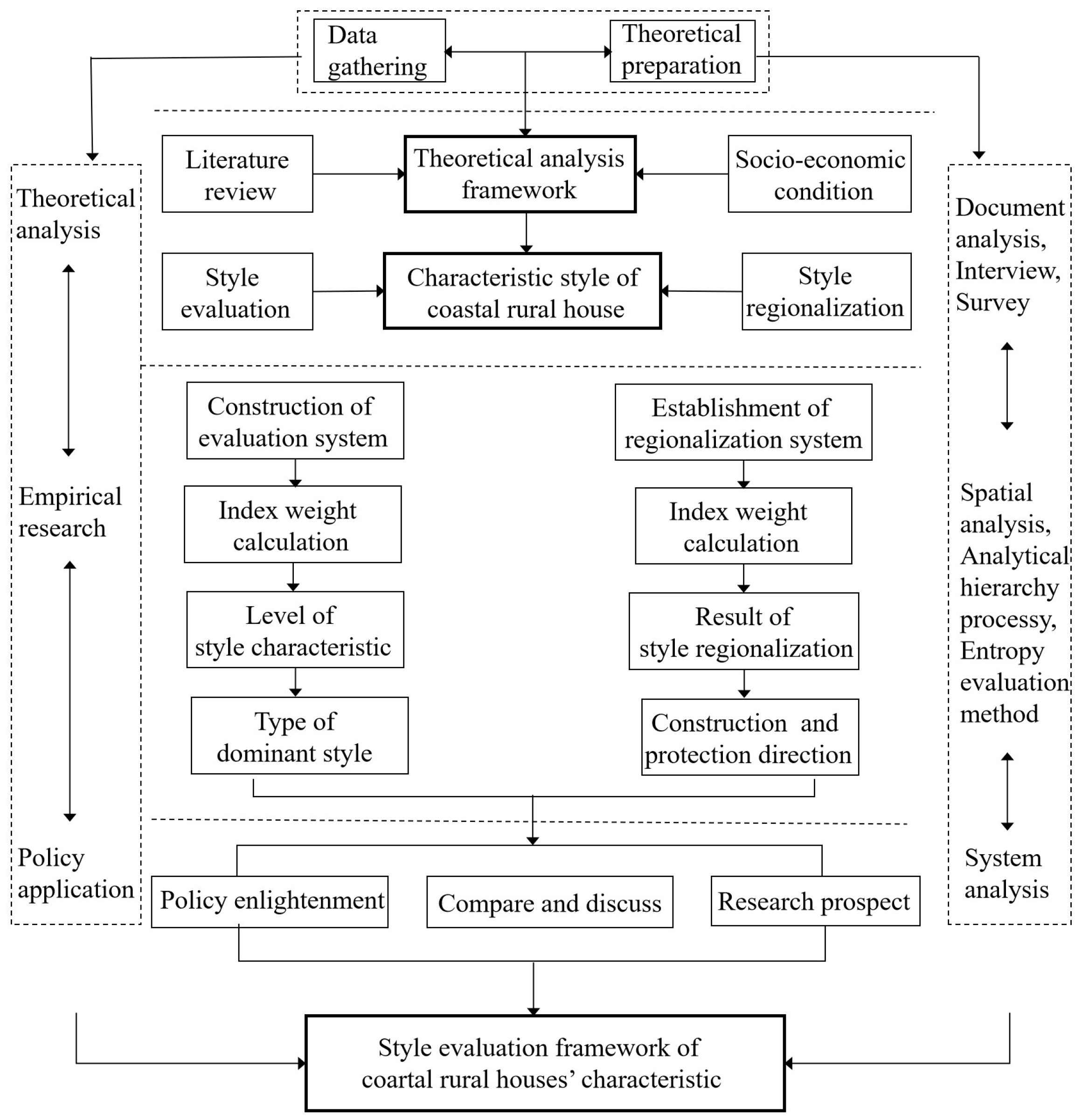

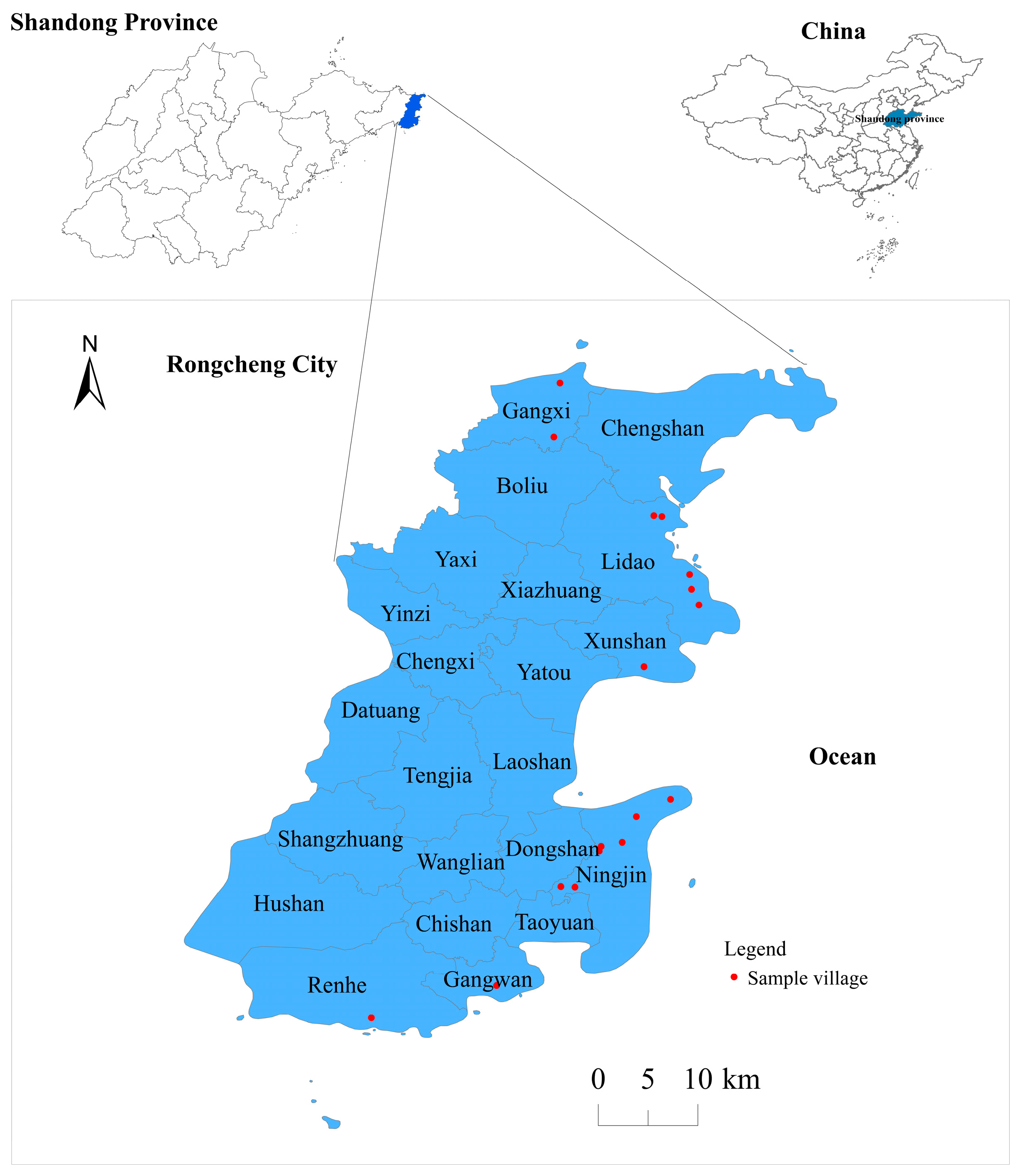
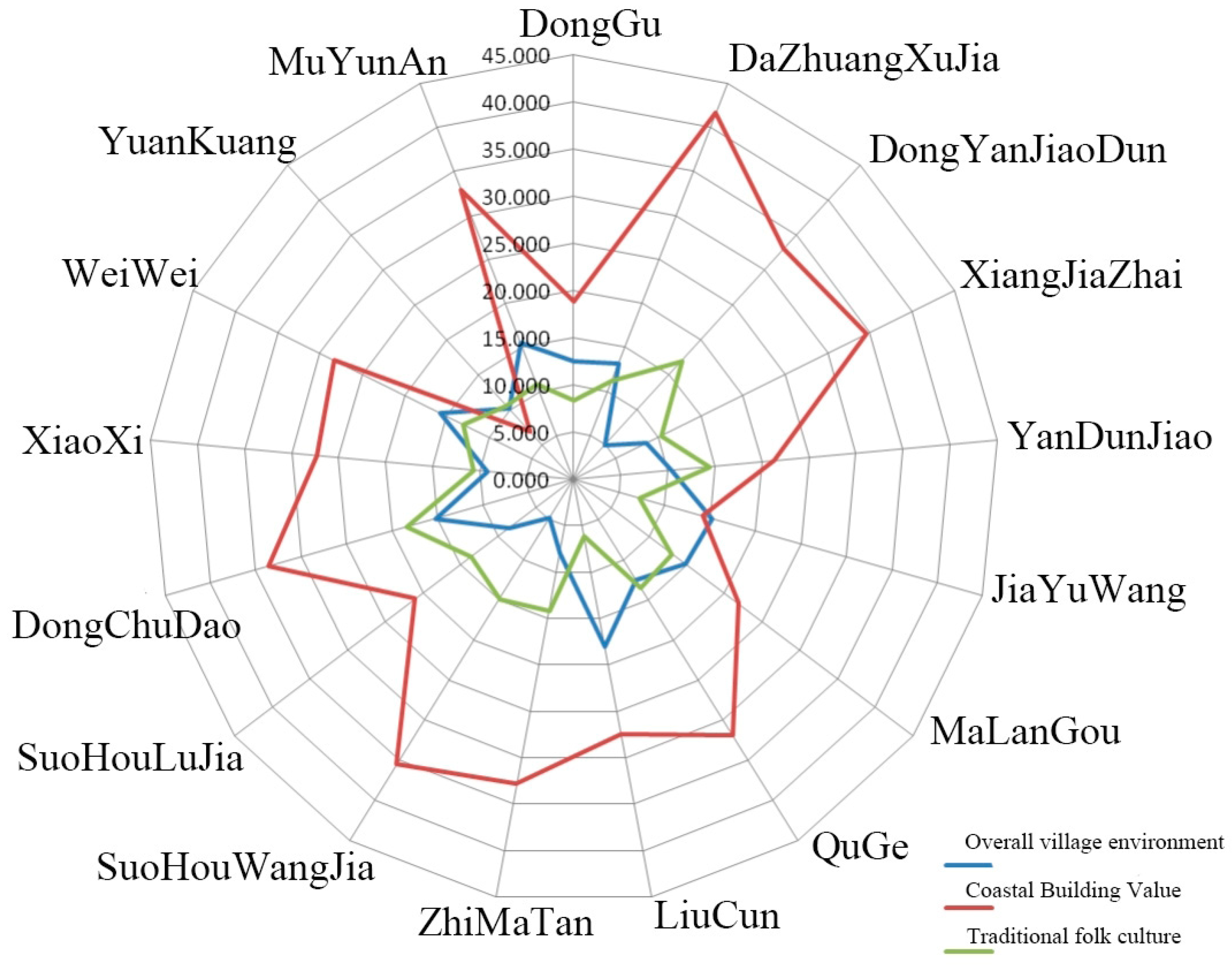
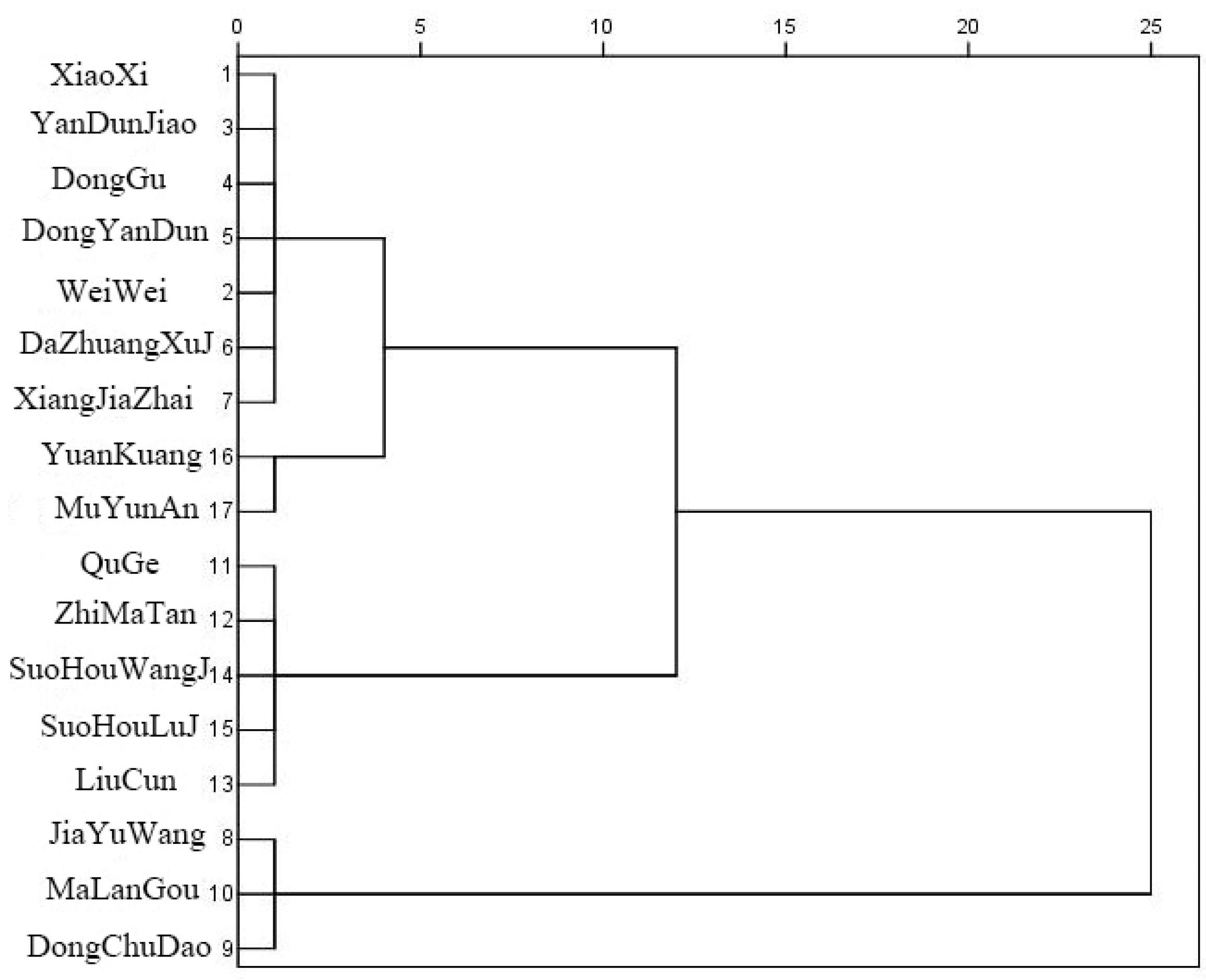
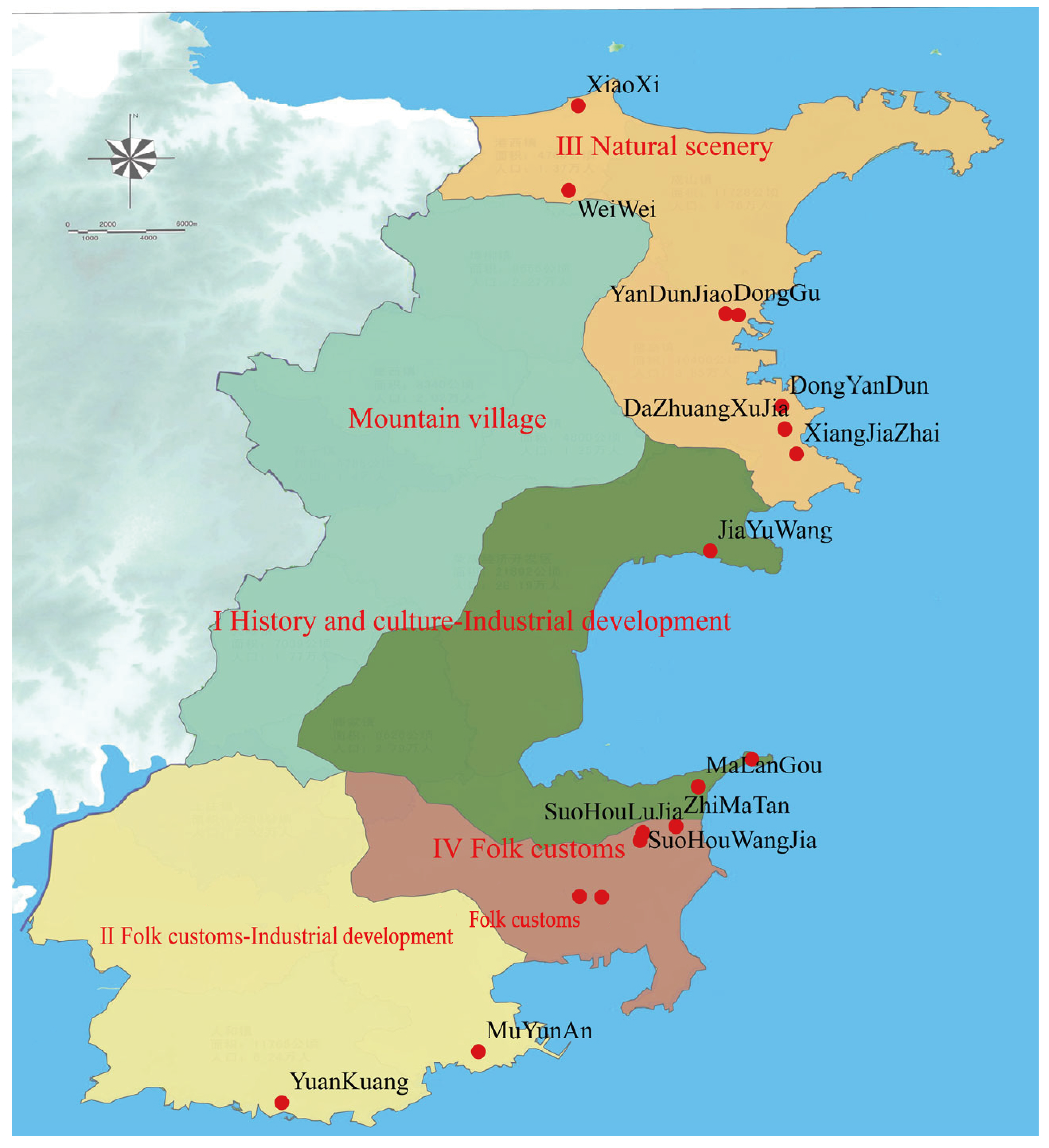
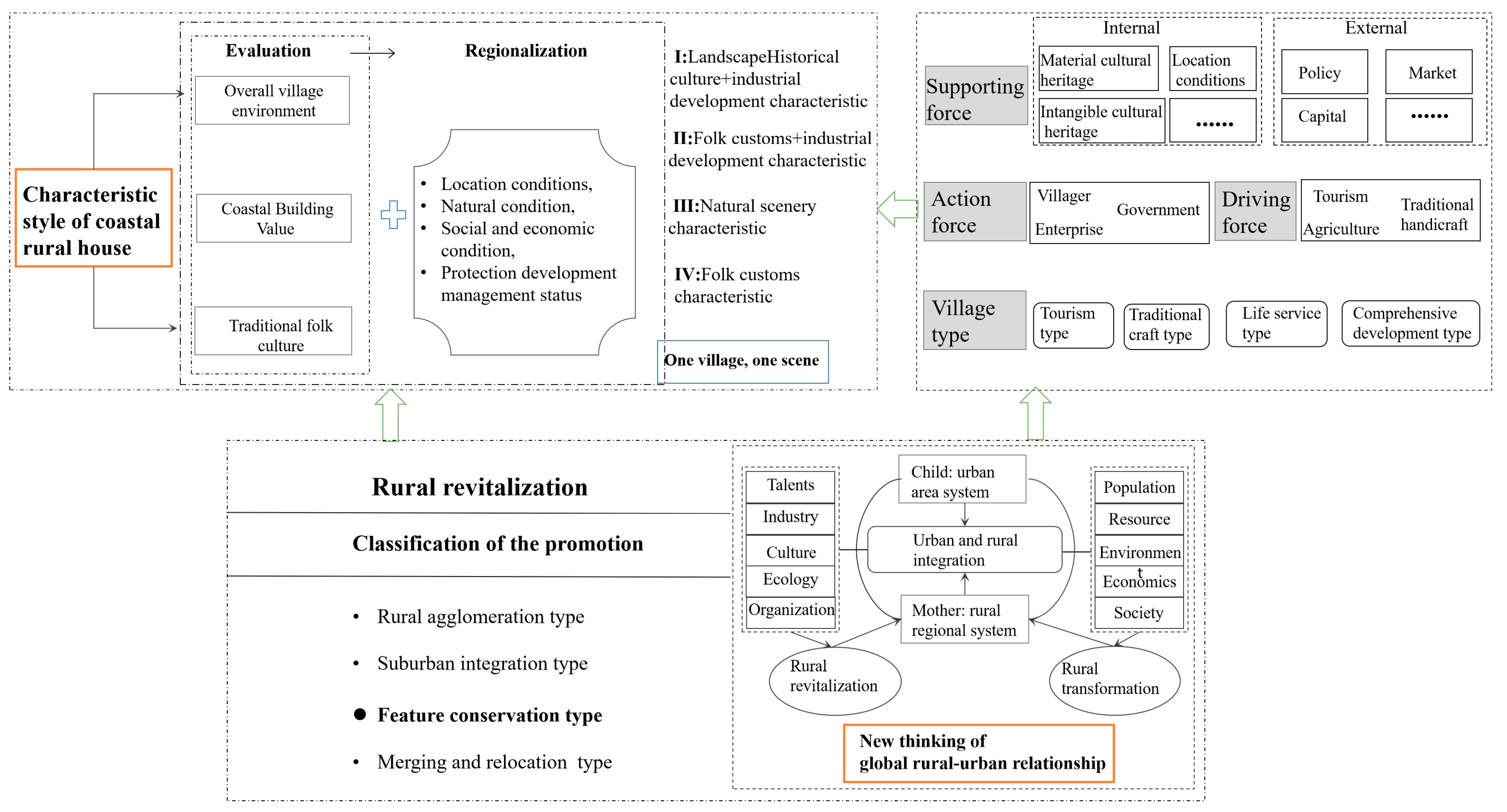
| Target Layer (A) | Comprehensive Evaluation Layer (B, Weight) | Factor Evaluation Layer (C, Weight) | Subfactor Evaluation Layer (D, Weight) | Data Sources | Weight |
|---|---|---|---|---|---|
| Evaluation Factors of Rural Residential Features A | B1 Overall village environment (0.25) | C1 Environmental Style and Overall Pattern (0.50) | D1 The beauty of village natural environment (0.52) | Field research | 0.065 |
| D2 Preservation degree of village traditional pattern (0.24) | Field research | 0.030 | |||
| D3 Longevity of the existing village (0.24) | Village archives | 0.030 | |||
| C2 Space Form of Streets and Courtyards (0.50) | D4 Total length of traditional streets (0.543) | UAV data + 3D laser scanning data | 0.068 | ||
| D5 Total area of traditional courtyard (0.457) | UAV data + 3D laser scanning data | 0.057 | |||
| B2 Coastal building value (0.5) | C3 Historic Value (0.25) | D6 Grade of cultural relics protection unit (0.82) | Village archives | 0.102 | |
| D7 Earliest building age of seagrass houses (0.18) | Village archives | 0.023 | |||
| C4 Characteristic Value (0.75) | D8 The area percentage of seagrass houses to village buildings (0.43) | Unmanned aerial vehicle data | 0.161 | ||
| D9 The quantity percentage of seagrass houses (0.224) | Village archives | 0.084 | |||
| D10 Percentage of seagrass house in good quality (0.346) | Village archives + field research | 0.130 | |||
| B3 Traditional folk culture (0.25) | C5 Uniqueness of Traditional Folk Culture (0.25) | D11 The quantity of customs, festivals, legends and poems (0.531) | Village archives + field research | 0.033 | |
| D12 The permanence of customs, festivals, legends and poems (0.469) | Village archives + field research | 0.029 | |||
| C6 The Maintenance Degree of Traditional Folk Skills (0.25) | D13 The quantity of handicrafts, traditional arts and performance forms (0.551) | Village archives + field research | 0.034 | ||
| D14 The permanence of handicrafts, traditional arts and performance forms (0.449) | Village archives + field research | 0.028 | |||
| C7 The Persistence Degree of Traditional Life Mode (0.50) | D15 The proportion of the population living in seagrass houses to the permanent population (0.55) | Village archives + field research | 0.069 | ||
| D16 The proportion of the population engaged in traditional production methods such as agriculture and fishery (0.45) | Village archives + field research | 0.057 |
| Target Layer (A) | Comprehensive Evaluation Layer (B, Weight) | Factor Evaluation Layer (C, Weight) | Subfactor Evaluation Layer (D, Weight) | Weight |
|---|---|---|---|---|
| Characteristic style regionalization of rural house | Overall village environment (0.15) | Environmental style and overall pattern (0.5) | The beauty of village natural environment (0.52) | 0.039 |
| Preservation degree of village traditional pattern (0.24) | 0.018 | |||
| Longevity of the existing village (0.24) | 0.018 | |||
| Space form of streets and courtyards (0.5) | Total length of traditional streets (0.54) | 0.040 | ||
| Total area of traditional courtyard (0.46) | 0.035 | |||
| Value of characteristic style of rural house (0.31) | Characteristic value of coastal building (0.5) | Grade of cultural relics protection unit (0.34) | 0.053 | |
| Earliest building age of seagrass houses (0.08) | 0.012 | |||
| The area percentage of seagrass houses to village buildings (0.25) | 0.039 | |||
| The quantity percentage of seagrass houses (0.13) | 0.020 | |||
| Percentage of seagrass house in good quality (0.20) | 0.031 | |||
| Traditional folk culture (0.5) | The quantity of customs, festivals, legends and poems (0.36) | 0.056 | ||
| The permanence of customs, festivals, legends and poems (0.28) | 0.043 | |||
| The quantity of handicrafts, traditional arts and performance forms (0.13) | 0.020 | |||
| The permanence of handicrafts, traditional arts and performance forms (0.11) | 0.017 | |||
| The proportion of the population living in seagrass houses to the permanent population (0.06) | 0.009 | |||
| The proportion of the population engaged in traditional production methods such as agriculture and fishery (0.05) | 0.008 | |||
| Location conditions (0.13) | Geographic position (0.57) | Latitude (1.00) | 0.074 | |
| Tourism location (0.29) | Distance to tourist attractions (1.00) | 0.038 | ||
| Road location (0.14) | Distance to main road (1.00) | 0.018 | ||
| Natural condition (0.06) | Terrain (0.25) | Plain better than hill better than mountain (1.00) | 0.015 | |
| Fishery resources (0.50) | Aquaculture area (1.00) | 0.03 | ||
| Elevation (0.25) | Elevation above sea level (1.00) | 0.015 | ||
| Social and economic condition (0.1) | Village scale (0.1) | Village area (1.00) | 0.010 | |
| Village economy (0.3) | Gross income (1.00) | 0.030 | ||
| Industry (0.3) | Proportion of primary industry (1.00) | 0.030 | ||
| Population (0.1) | Population size (1.00) | 0.010 | ||
| Construction land (0.1) | Construction land area (1.00) | 0.010 | ||
| Cultivated land (0.1) | agricultural acreage (1.00) | 0.010 | ||
| Protection development management status (0.25) | Protection planning measures (0.5) | Protection planning integrity (0.34) | 0.043 | |
| Implementation degree of protection planning (0.66) | 0.083 | |||
| Development business performance (0.5) | Infrastructure integrity (0.27) | 0.034 | ||
| Income per capita (0.73) | 0.092 |
| Number | Name | Overall Village Environment | Coastal Building Value | Traditional Folk Culture | Aggregate Score |
|---|---|---|---|---|---|
| 1 | DongChuDao | 15.262 | 33.573 | 18.376 | 67.211 |
| 2 | DaZhuangXuJia | 13.101 | 41.648 | 11.265 | 66.015 |
| 3 | MuYunAn | 15.468 | 32.925 | 10.776 | 59.169 |
| 4 | QuGe | 12.454 | 31.946 | 13.442 | 57.842 |
| 5 | WeiWei | 15.829 | 28.246 | 13.094 | 57.168 |
| 6 | SuoHouWangJia | 4.805 | 35.552 | 14.852 | 55.209 |
| 7 | ZhiMaTan | 8.003 | 32.834 | 14.116 | 54.953 |
| 8 | DongYanDun | 4.858 | 33.001 | 16.962 | 54.822 |
| 9 | XiangJiaZhai | 8.539 | 34.618 | 10.385 | 53.542 |
| 10 | LiuCun | 17.996 | 27.502 | 6.115 | 51.613 |
| 11 | MaLanGou | 14.839 | 21.873 | 13.036 | 49.749 |
| 12 | XiaoXi | 9.188 | 27.319 | 10.679 | 47.186 |
| 13 | YanDunJiao | 10.421 | 21.298 | 14.440 | 46.159 |
| 14 | SuoHouLuJia | 8.620 | 21.014 | 13.542 | 43.176 |
| 15 | DongGu | 12.532 | 18.772 | 8.342 | 39.646 |
| 16 | JiaYuWang | 15.223 | 14.164 | 7.160 | 36.547 |
| 17 | YuanKuang | 10.184 | 6.847 | 10.593 | 27.624 |
| Name | Total Score Ranking | Village Overall Environment Score Ranking | Coastal Building Value Score Ranking | Traditional Folk Culture Score Ranking | Characteristic Style Type |
|---|---|---|---|---|---|
| DongChuDao | 1 | 4 | 4 | 1 | Traditional Folk Culture Oriented |
| DaZhuangXuJia | 2 | 7 | 1 | 10 | Coastal Building Value Oriented |
| MuYunAn | 3 | 3 | 6 | 11 | Whole Village Environment Leading Type |
| QuGe | 4 | 9 | 8 | 7 | Traditional Folk Culture Oriented |
| WeiWei | 5 | 2 | 9 | 8 | Whole Village Environment Leading Type |
| SuoHouangJia | 6 | 17 | 2 | 3 | Coastal Building Value Oriented |
| ZhiMaTan | 7 | 15 | 7 | 5 | Traditional Folk Culture Oriented |
| DongYanDun | 8 | 16 | 5 | 2 | Traditional Folk Culture Oriented |
| XiangJiaZhai | 9 | 14 | 3 | 14 | Coastal Building Value Oriented |
| LiuCun | 10 | 1 | 10 | 17 | Whole Village Environment Leading Type |
| MaLanGou | 11 | 6 | 12 | 9 | Whole Village Environment Leading Type |
| XiaoXi | 12 | 12 | 11 | 12 | Coastal Building Value Oriented |
| YnaDunJiao | 13 | 10 | 13 | 4 | Traditional Folk Culture Oriented |
| SuoHouLuJia | 14 | 13 | 14 | 6 | Traditional Folk Culture Oriented |
| DongGu | 15 | 8 | 15 | 15 | Whole Village Environment Leading Type |
| JiaYuWang | 16 | 5 | 16 | 16 | Whole Village Environment Leading Type |
| YuanKuang | 17 | 11 | 17 | 13 | Whole Village Environment Leading Type |
| Type | Villages | Township (Street) | Tourism Spatial Pattern | Division Name |
|---|---|---|---|---|
| Ⅰ | DongChuDao | NingJin | Chu Dao Resort | Historical and cultural characteristics type |
| MaLanGou | NingJin | Chu Dao Resort | Historical and cultural characteristics type | |
| JiaYuWang | XunShan | Jiayuwang Tourist Resort | Historical and cultural characteristics type | |
| Ⅱ | MuYunAn | GangWan | Chishan Scenic Area | Folk customs + industrial development characteristic type |
| YuanKuang | RenHe | Chashan Scenic Area | Folk customs + industrial development characteristic type | |
| Ⅲ | XiaoXi | GangXi | Good Luck Corner Tourist Resort | Natural scenery characteristic type |
| WeiWei | GangXi | Good Luck Corner Tourist Resort | Natural scenery characteristic type | |
| YanDunJiao | LiDao | Good Luck Corner Tourist Resort | Natural scenery characteristic type | |
| DongGu | LiDao | Good Luck Corner Tourist Resort | Natural scenery characteristic type | |
| DongYanDunJiao | LiDao | Good Luck Corner Tourist Resort | Natural scenery characteristic type | |
| DaZhuangXuJia | LiDao | Good Luck Corner Tourist Resort | Natural scenery characteristic type | |
| XiangJiaZhai | LiDao | Good Luck Corner Tourist Resort | Natural scenery characteristic type | |
| Ⅳ | QuGe | NingJin | Shidao Bay Tourism Resort | Folk customs characteristic type |
| ZhiMaTan | NingJin | Shidao Bay Tourism Resort | Folk customs characteristic type | |
| LiuCun | NingJin | Shidao Bay Tourism Resort | Folk customs characteristic type | |
| SuoHouWangJia | NingJin | Shidao Bay Tourism Resort | Folk customs characteristic type | |
| SuoHouLuJia | NingJin | Shidao Bay Tourism Resort | Folk customs characteristic type |
Disclaimer/Publisher’s Note: The statements, opinions and data contained in all publications are solely those of the individual author(s) and contributor(s) and not of MDPI and/or the editor(s). MDPI and/or the editor(s) disclaim responsibility for any injury to people or property resulting from any ideas, methods, instructions or products referred to in the content. |
© 2023 by the authors. Licensee MDPI, Basel, Switzerland. This article is an open access article distributed under the terms and conditions of the Creative Commons Attribution (CC BY) license (https://creativecommons.org/licenses/by/4.0/).
Share and Cite
Zhao, Q.; Jiang, G.; Zhou, T.; Ma, W.; Yang, Y. Developing an Evaluation System Suitable for Coastal Rural Houses’ Characteristic Style and Its Inspiration for Rural Revitalization: Case Study of Rongcheng in Shandong Province. Int. J. Environ. Res. Public Health 2023, 20, 3010. https://doi.org/10.3390/ijerph20043010
Zhao Q, Jiang G, Zhou T, Ma W, Yang Y. Developing an Evaluation System Suitable for Coastal Rural Houses’ Characteristic Style and Its Inspiration for Rural Revitalization: Case Study of Rongcheng in Shandong Province. International Journal of Environmental Research and Public Health. 2023; 20(4):3010. https://doi.org/10.3390/ijerph20043010
Chicago/Turabian StyleZhao, Qinglei, Guanghui Jiang, Tao Zhou, Wenqiu Ma, and Yuting Yang. 2023. "Developing an Evaluation System Suitable for Coastal Rural Houses’ Characteristic Style and Its Inspiration for Rural Revitalization: Case Study of Rongcheng in Shandong Province" International Journal of Environmental Research and Public Health 20, no. 4: 3010. https://doi.org/10.3390/ijerph20043010
APA StyleZhao, Q., Jiang, G., Zhou, T., Ma, W., & Yang, Y. (2023). Developing an Evaluation System Suitable for Coastal Rural Houses’ Characteristic Style and Its Inspiration for Rural Revitalization: Case Study of Rongcheng in Shandong Province. International Journal of Environmental Research and Public Health, 20(4), 3010. https://doi.org/10.3390/ijerph20043010











